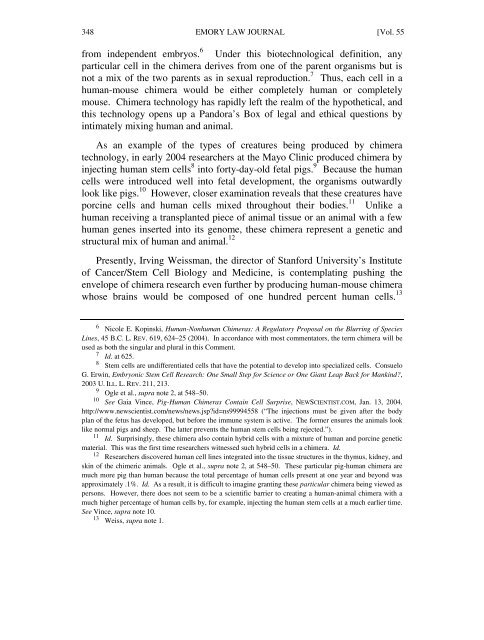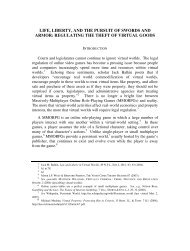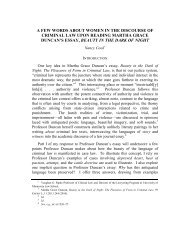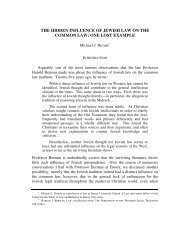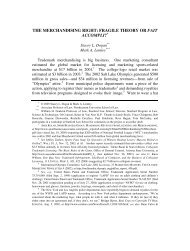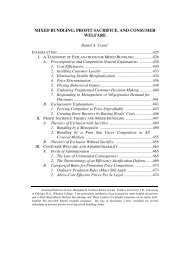Chimera and the Continuum of Humanity - Emory University School ...
Chimera and the Continuum of Humanity - Emory University School ...
Chimera and the Continuum of Humanity - Emory University School ...
You also want an ePaper? Increase the reach of your titles
YUMPU automatically turns print PDFs into web optimized ePapers that Google loves.
348 EMORY LAW JOURNAL [Vol. 55<br />
from independent embryos. 6 Under this biotechnological definition, any<br />
particular cell in <strong>the</strong> chimera derives from one <strong>of</strong> <strong>the</strong> parent organisms but is<br />
not a mix <strong>of</strong> <strong>the</strong> two parents as in sexual reproduction. 7 Thus, each cell in a<br />
human-mouse chimera would be ei<strong>the</strong>r completely human or completely<br />
mouse. <strong>Chimera</strong> technology has rapidly left <strong>the</strong> realm <strong>of</strong> <strong>the</strong> hypo<strong>the</strong>tical, <strong>and</strong><br />
this technology opens up a P<strong>and</strong>ora’s Box <strong>of</strong> legal <strong>and</strong> ethical questions by<br />
intimately mixing human <strong>and</strong> animal.<br />
As an example <strong>of</strong> <strong>the</strong> types <strong>of</strong> creatures being produced by chimera<br />
technology, in early 2004 researchers at <strong>the</strong> Mayo Clinic produced chimera by<br />
injecting human stem cells 8 into forty-day-old fetal pigs. 9 Because <strong>the</strong> human<br />
cells were introduced well into fetal development, <strong>the</strong> organisms outwardly<br />
look like pigs. 10 However, closer examination reveals that <strong>the</strong>se creatures have<br />
porcine cells <strong>and</strong> human cells mixed throughout <strong>the</strong>ir bodies. 11 Unlike a<br />
human receiving a transplanted piece <strong>of</strong> animal tissue or an animal with a few<br />
human genes inserted into its genome, <strong>the</strong>se chimera represent a genetic <strong>and</strong><br />
structural mix <strong>of</strong> human <strong>and</strong> animal. 12<br />
Presently, Irving Weissman, <strong>the</strong> director <strong>of</strong> Stanford <strong>University</strong>’s Institute<br />
<strong>of</strong> Cancer/Stem Cell Biology <strong>and</strong> Medicine, is contemplating pushing <strong>the</strong><br />
envelope <strong>of</strong> chimera research even fur<strong>the</strong>r by producing human-mouse chimera<br />
whose brains would be composed <strong>of</strong> one hundred percent human cells. 13<br />
6 Nicole E. Kopinski, Human-Nonhuman <strong>Chimera</strong>s: A Regulatory Proposal on <strong>the</strong> Blurring <strong>of</strong> Species<br />
Lines, 45 B.C. L. REV. 619, 624–25 (2004). In accordance with most commentators, <strong>the</strong> term chimera will be<br />
used as both <strong>the</strong> singular <strong>and</strong> plural in this Comment.<br />
7 Id. at 625.<br />
8 Stem cells are undifferentiated cells that have <strong>the</strong> potential to develop into specialized cells. Consuelo<br />
G. Erwin, Embryonic Stem Cell Research: One Small Step for Science or One Giant Leap Back for Mankind?,<br />
2003 U. ILL. L. REV. 211, 213.<br />
9 Ogle et al., supra note 2, at 548–50.<br />
10 See Gaia Vince, Pig-Human <strong>Chimera</strong>s Contain Cell Surprise, NEWSCIENTIST.COM, Jan. 13, 2004,<br />
http://www.newscientist.com/news/news.jsp?id=ns99994558 (“The injections must be given after <strong>the</strong> body<br />
plan <strong>of</strong> <strong>the</strong> fetus has developed, but before <strong>the</strong> immune system is active. The former ensures <strong>the</strong> animals look<br />
like normal pigs <strong>and</strong> sheep. The latter prevents <strong>the</strong> human stem cells being rejected.”).<br />
11 Id. Surprisingly, <strong>the</strong>se chimera also contain hybrid cells with a mixture <strong>of</strong> human <strong>and</strong> porcine genetic<br />
material. This was <strong>the</strong> first time researchers witnessed such hybrid cells in a chimera. Id.<br />
12 Researchers discovered human cell lines integrated into <strong>the</strong> tissue structures in <strong>the</strong> thymus, kidney, <strong>and</strong><br />
skin <strong>of</strong> <strong>the</strong> chimeric animals. Ogle et al., supra note 2, at 548–50. These particular pig-human chimera are<br />
much more pig than human because <strong>the</strong> total percentage <strong>of</strong> human cells present at one year <strong>and</strong> beyond was<br />
approximately .1%. Id. As a result, it is difficult to imagine granting <strong>the</strong>se particular chimera being viewed as<br />
persons. However, <strong>the</strong>re does not seem to be a scientific barrier to creating a human-animal chimera with a<br />
much higher percentage <strong>of</strong> human cells by, for example, injecting <strong>the</strong> human stem cells at a much earlier time.<br />
See Vince, supra note 10.<br />
13 Weiss, supra note 1.


